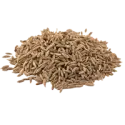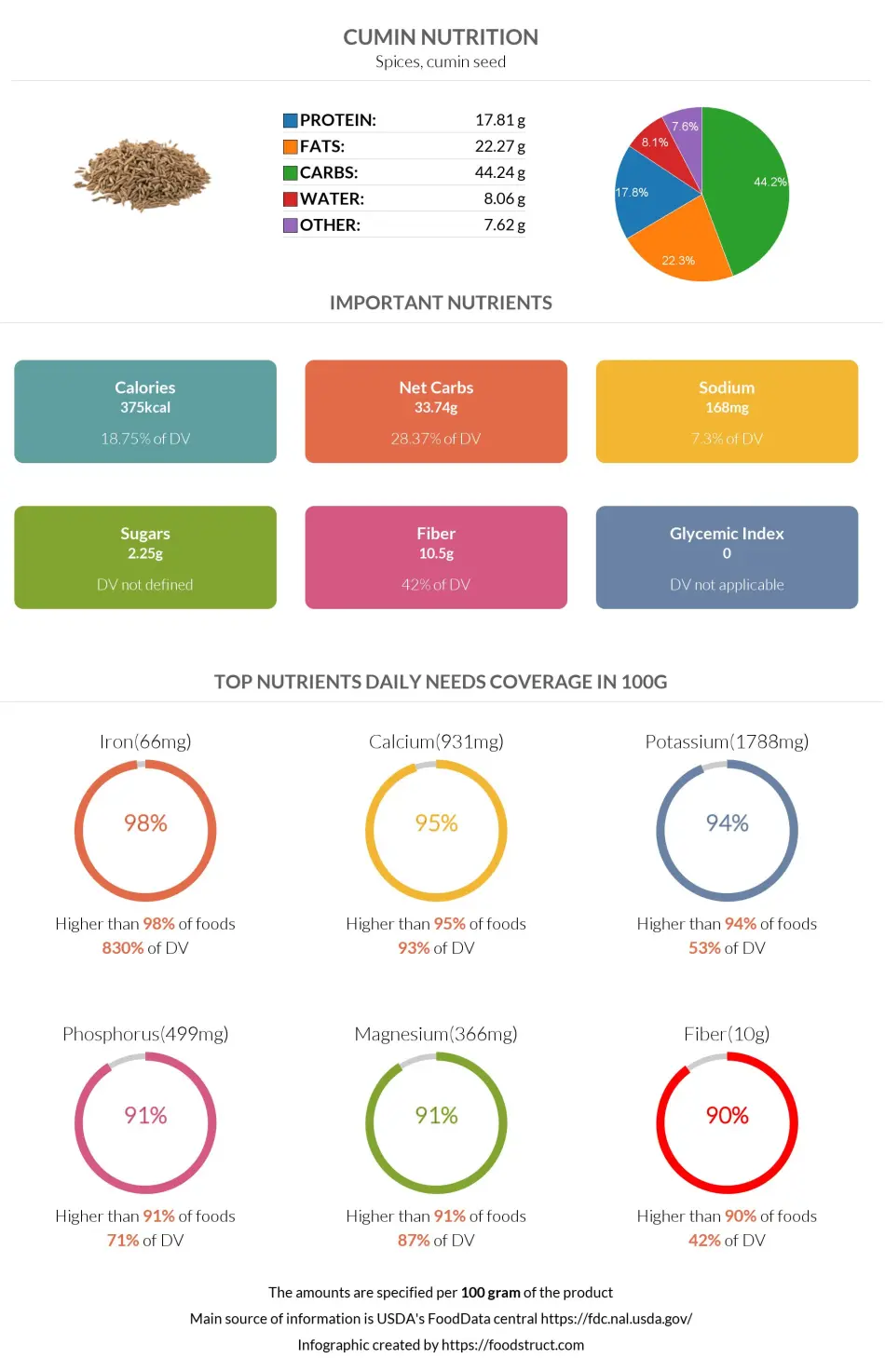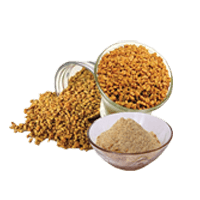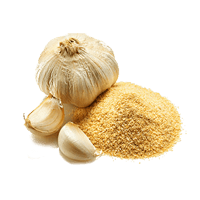Cumin Nutrition & Health – Complete Data of All Nutrients

Introduction
For centuries, cumin seeds have been used in various cuisines and cultures all over the world, not only as a worldwide but also as a therapeutic agent.
In this article, we will talk about the nutrition and health benefits of cumin, based on scientific evidence, and discuss what diets it fits in, its consumption and production, and other exciting aspects.
Classification
Cumin is the dried seed of the herb called Cuminum cyminum, commonly used as a spice in different cuisines. Cumin is also known by its alternative name, jeera or zeera.
Cumin cyminum is a flowering plant belonging to the Apiaceae family, also known as the parsley family, that includes celery, carrots, anise, dill, and other edible plants.
Ground and Whole Cumin
Both ground and whole-seed cumin are used in the kitchen. Ground cumin is produced by grinding dry-roasted seeds of the plant.
Cumin seeds retain their taste for a longer period, as opposed to ground cumin. However, ground cumin changes the dish's taste to which it is added immediately.
Serving Size
The amount of cumin used in a serving size of a dish has been calculated to be a quarter of a teaspoon, equalling 0.5 grams.
Nutrition
Adding cumin to a dish can slightly alter its nutritional value. This article examines the nutritional value of 100g serving size of cumin seeds. However, the standard servings of cumin are equal to one tbsp /6g/ or one tsp /2.1g/.
Macronutrients
The predominant macronutrients in cumin are carbohydrates, making up 44 percent. These carbohydrates consist primarily of dietary fiber with only a few sugars.
One average serving size of cumin contains only 0.22g of carbs, of which 0.05g is fiber and 0.17g are net carbs.
The next macronutrients by content are fats. 22% of cumin consists of fats. However, most of that fat is comprised of monounsaturated fatty acids, followed by polyunsaturated fatty acids, leaving unsaturated fatty acids in the last place.
And lastly, proteins make up 18% of cumin’s composition.
Macronutrients chart
Fats
Cumin is an excellent source of healthy fats. A 100g serving contains 17g of unsaturated fats. Saturated fat content equals 1.5g per 100g. However, cumin is not consumed in such amounts, so the fat content in dishes with cumin counts from the other ingredients.
Fat type information
Fiber
The fiber content in cumin equals 10.5g out of 44.2g of carbs. It contains both insoluble and soluble types of fiber. Cumin is richer in insoluble fiber.
Fiber content ratio for Cumin
Calories
A 100g of cumin contains 375 calories. However, cumin is never consumed in such large amounts as a spice. The average amount of cumin used in one serving size of a dish contains around 2 calories. Therefore, cumin does not substantially change the caloric content of a dish.
Vitamins
Adding cumin to dishes can be a good source of supplementary vitamins.
Cumin is very rich in vitamin B1 and vitamin A. It also contains high amounts of vitamins B2, C, and B6. Cumin has moderate vitamins B3, E, K, and folate (vitamin B9).
This spice completely lacks vitamin D and vitamin B12.
Vitamin coverage chart
Minerals
Cumin is very high in iron, calcium, potassium, magnesium, phosphorus, and copper. It also contains moderate amounts of zinc, manganese, selenium, and choline.
Cumin is relatively high in sodium.
Mineral coverage chart
Oxalates
Oxalates are compounds found in many vegetables, which may bind to calcium in the bloodstream, increasing the risk of kidney stone formation.
Cumin oxalate content is considered high: it contains 1513mg of them per 100 grams (25).
Phytochemicals
Cumin is rich in a wide range of phytochemicals responsible for its antioxidant capacities.
Flavonoids
Flavonoids are a powerful group of antioxidants that have anticancer, antimicrobial, and neuroprotective capacities, as well (26). According to a study, cumin seeds originating from France and Syria have the highest flavonoid content (27).
Phenols
Phenolic compounds are the primary group of antioxidants in plants. Cumin is notably rich in phenols. French cumin seeds contain 69.4mg of phenolic compounds per 1 gram of extract (27). Fresh, unprocessed cumin contains the highest amounts of phenols. Black cumin seeds treated with edible salt have lower phenolic content than natural cumin seeds (28).
Glycemic Index
Due to the shallow carb content of 0.17g in one serving size of cumin, its glycemic index value can be considered close to 0.
Cumin has been studied to lower the glycemic index of the dish to which it is added. Adding cumin to a control dish reduced its glycemic index from 97 to 86 (1).
Acidity
Cumin is a slightly alkaline spice with a pH of 7.3 (2). It has been used in traditional Ayurvedic medicine to regulate hyperacidity.
The acidity of cumin based on potential renal acid load (PRAL) has been calculated to be -32, making this spice alkaline-forming.
Health Impact
Cuminum cyminum has been widely used in Ayurvedic medicine to treat indigestion, diarrhea, and jaundice (3). Here, we will look more deeply into the effects and mechanisms of cumin on human health. These biomedical activities of cumin are most likely due to certain bioactive ingredients within cumin, such as terpenes, phenols, and flavonoids (4). However, cumin is consumed in tiny amounts, and these phytochemicals do not have any recorded health impacts connected to cumin consumption.
Cardiovascular
Cardioprotective Effects
Fruits of Cuminum cyminum are rich in phytoestrogens. Estrogens in the body benefit lipid metabolism, therefore protecting the heart from conditions such as coronary heart disease. During menopause, estrogen levels significantly decrease, leaving the person vulnerable to heart disease. A study has shown the hypolipidemic activities of cumin's methanolic extract, making it a potential element for treating certain menopausal disorders (5).
These hypolipidemic and cardioprotective effects have also been shown in experiments with rabbits (6).
Hypotensive Effects
Cumin has been traditionally used in Ayurvedic medicine to treat high blood pressure.
Oral administration of cumin seeds in rats has decreased systolic blood pressure and increased plasma nitric oxide levels. Nitric oxide is responsible for relaxing muscles in blood vessels and further lowering blood pressure. This study has also demonstrated that cumin alleviates inflammation and oxidative stress (7).
Another research has found that Cuminum cyminum essential oil significantly decreased diastolic blood pressure (8).
Antioxidant Effects
One research has found cumin can reduce levels of low-density lipoproteins and increase the activity of antioxidant enzymes, such as paraoxonase and arylesterase, which protect lipids from oxidation (9).
However, another study did not show cumin's cholesterol-lowering properties in rats, even when consumed five times the average human intake level (10).
Diabetes
Antihyperglycemic Effects
Many studies have shown that cumin can lower blood glucose levels.
Cumin supplementation in alloxan-induced diabetic rats has resulted in a significant reduction in blood glucose and an increase in total hemoglobin and glycosylated hemoglobin. It also prevented a decrease in body weight and reduced total and plasma cholesterol levels. Cumin supplementation was more effective than glibenclamide in treating diabetes mellitus type 2 (3).
An eight-week dietary regimen containing cumin powder reduced hyperglycemia and glucosuria in rats, improved body weight, and countered other metabolic alterations (11).
Contrastingly, one research has found that adding an aqueous extract of cumin at dietary doses, in two separate forms, to high glycemic index rice in healthy volunteers demonstrated no additional benefits on postprandial glycemia or insulinemia. However, this does not eliminate other long-term beneficial effects (12).
Cancer
Chemopreventive Effects
Studies suggest that the chemopreventive effects of cumin can be attributed to its ability to modulate carcinogen metabolism. Experiments on mice have shown significant inhibition of stomach tumor growth and uterine cervix tumor growth by cumin (13).
Another research has demonstrated that chili supplementation promotes colon cancer in rats, whereas cumin or black pepper supplementation suppresses colon cancer formation in the presence of a procarcinogen (14).
Cumin residue, generated from Ayurvedic industries, has a stronger anticancer activity by arresting the cell cycle and inducing apoptosis in colon cancer cells, as opposed to raw cumin (15).
Other properties of cumin that have been studied include antimicrobial, analgesic, antistress, memory enhancing, antithrombotic, antiulcer, digestive stimulant, weight reducing, antiosteoporotic, contraceptive, immunological, bronchodilatory, protective, and more (2).
Allergy
Since many spices and flavorings are derived from plants, they can cause allergic reactions. Though rare, cumin allergies do occur, at times causing food-induced anaphylaxis (16).
Spices can cause both allergic and non-allergic reactions, and it is essential to differentiate the two. Non-allergic reactions usually do not need immediate medical care. These can be expressed as a rash where the spice has touched the skin, localized itching in the mouth, or cough due to inhalation (17).
A common allergen found in cumin is the protein called profilin. Hypersensitivity to profilin can also cause allergic reactions triggered by anise, coriander, and dill. Cumin allergy may also cross-react with mugwort and pollen allergy (18).
Symptoms of a cumin allergy, like all food allergies, may range from mild to severe. Using cumin for the first time may not cause any symptoms. Symptoms may appear the second time and onwards, such as rashes, oral allergy syndrome (itching, swelling, and tingling of the mouth area), coughing, diarrhea, abdominal pain, and vomiting. In rare cases, cumin allergy may lead to anaphylactic shock.
Cumin in Diets
| iKeto | While cumin does contain carbohydrates, as only a tiny amount is added to the dish, it does not make a significant difference. Cumin is considered a keto-friendly seasoning due to its low net carbs per serving. However, it is essential to remember the hidden carbs that cumin can provide on a keto diet. |
| DASH | Cumin can be considered to be relatively high in sodium. However, it has been researched to have hypotensive effects and is used in traditional medicine to treat high blood pressure (6). Exchanging salt for cumin can be a way to reduce sodium intake. |
| Atkins | All fresh herbs and small amounts of dried herbs, including cumin, are acceptable in Phase One and onwards on an Atkins diet (19). |
| Mediterranean | As cumin has likely originated in an Eastern Mediterranean region, it perfectly fits this diet (20). |
| Paleo | Cumin, as a natural spice, fits the Paleo diet (21). |
| Vegan/ Vegetarian/ Pescetarian | Cumin is a plant product and naturally fits in all three diets. |
| Dukan | Most natural, sugar-free spices are acceptable during the Dukan diet; therefore, you can use cumin on this diet (22). |
| Intermittent Fasting | Naturally, you can use cumin as a spice during the eating periods, but not during fasting. |
| Low Fat & Low Calorie | Cumin adds only 2 calories to the average serving size of a seasoned dish. Cumin can be used as a spice in low-fat and low-calorie diets. |
| Low Carb | Cumin adds less than half a gram of carbohydrates to a dish. If the seasoned dish is consumed in moderation, cumin’s carb content can be ignored. |
| Anti Inflammatory studies | Studies have shown cumin to have certain anti-inflammatory qualities (6). |
| BRAT | Seasonings that are not spicy or strong are acceptable during the BRAT diet. Therefore, cumin can be used on this diet in moderate amounts. |
Black Cumin
The scientific name of black cumin is Nigella sativa, belonging to the Ranunculaceae family. It has many names, often called fennel flower, black caraway, black seed, nutmeg flower, Roman coriander, and kala jeera. Both cumin and black cumin are used as seasonings and have many beneficial health effects; however, they are completely unrelated (4).
Sometimes, a plant called Bunium Bulbocastanum can also be referred to as black cumin. This plant is unrelated to both common cumin and Nigella sativa as well.
Cooking
Cumin can be used in dishes in its ground form or as a whole seed. One tablespoon of ground cumin equals a quarter tablespoon of whole seeds. Cumin’s taste is often described as earthy, with a bit of both sweetness and bitterness.
Cumin is a common ingredient in Indian cuisine and is a prominent component of famous curry powder and garam masala spice mixtures. Cumin is also used to make jeera rice.
Cumin can also be found in Mexican cuisine, where it is used to flavor cheeses or in baking (23).
Cumin seeds can also be used to make tea.
Due to similarities in taste and properties, ground coriander and caraway seeds can be substituted for cumin.
Keeping, Storing, and Conservation
Cumin seeds can be kept in the freezer for a long period to maintain their flavor if you do not use them regularly; otherwise, they can be stored in the pantry for up to 3 to 4 years. Ground cumin should be stored in a cool, dark place in a tightly sealed container for up to 6 months.
If possible, it is advised to store cumin as whole seeds and grind them whenever needed, as whole seeds keep the flavor longer.
Consumption and Production
Cumin is native to Egypt and cultivated in the Middle East, India, China, and Mediterranean countries for millennials. The plant possibly originated in the Mediterranean area, perhaps Egypt and Syria. Nowadays, it is cultivated extensively in Turkey, India, China, Iraq, Libya, and Palestine.
In the past, the largest cumin exporter to the United States was Iran. However, currently, Turkey, India, and China have provided alternatives. Now, the primary production of cumin is established in India (the states of Rajasthan and Gujarat) (2).
Being the leading producer and consumer of cumin, India produces 70% of the world’s supply and consumes 90% of that (which means that India consumes 63% of the world’s cumin). Other producers are Syria (7%), Iran (6%), and Turkey (6%). The remaining 11% comes from other countries. In total, around 300,000 tons of cumin per year are produced worldwide (24).
References
- https://www.ncbi.nlm.nih.gov/pmc/articles/PMC5897315/
- http://www.iosrphr.org/papers/v6i6V2/G066024665.pdf
- https://pubmed.ncbi.nlm.nih.gov/12220968/
- https://academic.oup.com/fqs/article/2/1/1/4823052
- https://www.ncbi.nlm.nih.gov/pmc/articles/PMC2841243/
- https://www.researchgate.net/publication/328193257
- https://www.tandfonline.com/doi/abs/10.3109/10641963.2013.764887
- https://onlinelibrary.wiley.com/doi/full/10.1002/ptr.6500?af=R
- https://www.ncbi.nlm.nih.gov/pmc/articles/PMC4039583/
- https://onlinelibrary.wiley.com/doi/abs/10.1002/food.19910350112
- https://www.sciencedirect.com/science/article/pii/S0271531797002078
- https://www.researchgate.net/publication/336038597
- https://www.tandfonline.com/doi/abs/10.1207/s15327914nc4702_10
- https://pubmed.ncbi.nlm.nih.gov/16822210/
- https://link.springer.com/article/10.1007/s13197-016-2372-z
- https://www.jacionline.org/article/S0091-6749(97)70039-3/fulltext
- https://www.aaaai.org/conditions-and-treatments/library/allergy-library/spice-allergy
- https://pubmed.ncbi.nlm.nih.gov/9420134/
- https://au.atkins.com/static/default/files/documents/pdf/Atkins%20Food%20List.pdf
- https://books.google.am/books?id=e-glDQAAQBAJ&pg=PA234&redir_esc=y#v=onepage&q&f=false
- https://www.paleopowderseasoning.com/blogs/news/but-all-seasonings-are-paleo-right
- https://mydukandiet.com/dieting/faq/what-spices-can-i-eat-on-dukan-diet.html
- https://www.bbc.co.uk/food/cumin
- http://www.irancuminseed.com/iran-cumin-seed/
- https://www.researchgate.net/publication/223973698_Total_and_Soluble_Oxalate_Content_of_Some_Indian_Spices
- https://www.ncbi.nlm.nih.gov/pmc/articles/PMC7697716/#:~:text=Flavonoids%20possess%20a%20number%20of,neuroprotective%20and%20cardio-protective%20effects.
- https://www.ncbi.nlm.nih.gov/pmc/articles/PMC7407589/
- https://pubmed.ncbi.nlm.nih.gov/21049998/
Top nutrition facts for Cumin

| Calories ⓘ Calories for selected serving | 375 kcal |
|
Glycemic index ⓘ
Source: 86 with glucose (glucose 97) https://www.ncbi.nlm.nih.gov/pmc/articles/PMC5897315/
Check out our Glycemic index chart page for the full list.
|
0 (low) |
| Net Carbs ⓘ Net Carbs = Total Carbohydrates – Fiber – Sugar Alcohols | 34 grams |
| Acidity (Based on PRAL) ⓘ PRAL (Potential renal acid load) is calculated using a formula. On the PRAL scale the higher the positive value, the more is the acidifying effect on the body. The lower the negative value, the higher the alkalinity of the food. 0 is neutral. | -32 (alkaline) |
| Oxalates ⓘ https://www.researchgate.net/publication/223973698 | 1513 mg |
Cumin calories (kcal)
| Calories for different serving sizes of cumin | Calories | Weight |
|---|---|---|
| Calories in 100 grams | 375 | |
| Calories in 0.25 tsp, whole | 2 | 0.5 g |
| Calories in 1 tbsp, whole | 23 | 6 g |
Cumin Glycemic index (GI)
Mineral chart - relative view
Vitamin chart - relative view
All nutrients for Cumin per 100g
| Nutrient | Value | DV% | In TOP % of foods | Comparison |
| Vitamin A | 64µg | 7% | 31% | |
| Calories | 375kcal | 19% | 19% |
8 times more than Orange
|
| Protein | 18g | 42% | 29% |
6.3 times more than Broccoli
|
| Fats | 22g | 34% | 13% |
1.5 times less than Cheese
|
| Vitamin C | 7.7mg | 9% | 26% |
6.9 times less than Lemon
|
| Net carbs | 34g | N/A | 24% |
1.6 times less than Chocolate
|
| Carbs | 44g | 15% | 23% |
1.6 times more than Rice
|
| Cholesterol | 0mg | 0% | 100% |
N/A
|
| Vitamin D | 0µg | 0% | 100% |
N/A
|
| Magnesium | 366mg | 87% | 9% |
2.6 times more than Almonds
|
| Calcium | 931mg | 93% | 5% |
7.4 times more than Milk
|
| Potassium | 1788mg | 53% | 6% |
12.2 times more than Cucumber
|
| Iron | 66mg | 830% | 2% |
25.5 times more than Beef broiled
|
| Sugar | 2.3g | N/A | 58% |
4 times less than Coca-Cola
|
| Fiber | 11g | 42% | 10% |
4.4 times more than Orange
|
| Copper | 0.87mg | 96% | 17% |
6.1 times more than Shiitake
|
| Zinc | 4.8mg | 44% | 20% |
1.3 times less than Beef broiled
|
| Phosphorus | 499mg | 71% | 9% |
2.7 times more than Chicken meat
|
| Sodium | 168mg | 7% | 44% |
2.9 times less than White bread
|
| Vitamin E | 3.3mg | 22% | 38% |
2.3 times more than Kiwi
|
| Manganese | 3.3mg | 145% | 26% | |
| Selenium | 5.2µg | 9% | 67% | |
| Vitamin B1 | 0.63mg | 52% | 14% |
2.4 times more than Pea raw
|
| Vitamin B2 | 0.33mg | 25% | 23% |
2.5 times more than Avocado
|
| Vitamin B3 | 4.6mg | 29% | 36% |
2.1 times less than Turkey meat
|
| Vitamin B6 | 0.44mg | 33% | 29% |
3.7 times more than Oats
|
| Vitamin B12 | 0µg | 0% | 100% |
N/A
|
| Vitamin K | 5.4µg | 5% | 55% |
18.8 times less than Broccoli
|
| Folate | 10µg | 3% | 62% |
6.1 times less than Brussels sprouts
|
| Choline | 25mg | 4% | 73% | |
| Saturated fat | 1.5g | 8% | 53% |
3.8 times less than Beef broiled
|
| Monounsaturated fat | 14g | N/A | 12% |
1.4 times more than Avocado
|
| Polyunsaturated fat | 3.3g | N/A | 23% |
14.4 times less than Walnut
|
| Caffeine | 0mg | 0% | 100% | |
| Omega-3 - EPA | 0g | N/A | 100% |
N/A
|
| Omega-3 - DHA | 0g | N/A | 100% |
N/A
|
| Omega-3 - DPA | 0g | N/A | 100% |
N/A
|
Check out similar food or compare with current
NUTRITION FACTS LABEL
Serving Size ______________
Health checks
Cumin nutrition infographic

References
All the values for which the sources are not specified explicitly are taken from FDA’s Food Central. The exact link to the food presented on this page can be found below.



